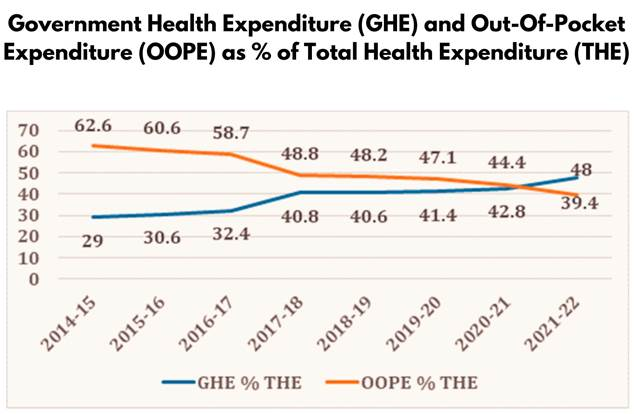Governance
National Health Account (NHA) Estimates 2020-21 and 2021-22
- 08 Oct 2024
- 8 min read
For Prelims: National Health Account (NHA), Covid-19 pandemic, Out-of-Pocket Expenditure (OOPE), National Health Accounts Guidelines for India, 2016, National Health Mission, Ayushman Bharat, Pradhan Mantri Jan Arogya Yojana (AB-PMJAY), National Medical Commission, PM National Dialysis Programme, Janani Shishu Suraksha Karyakram (JSSK), Rashtriya Bal Swasthya Karyakram (RBSK)
For Mains: Various initiatives taken by the government in Healthcare.
Why in News?
Recently, the Union Ministry of Health and Family Welfare has released the National Health Account (NHA) estimates for the fiscal years 2020-21 and 2021-22.
- These reports are the eighth and ninth editions of the NHA series, offering a comprehensive overview of the country's healthcare expenditure.
What are the Key Findings of NHA Estimates for 2020-21 and 2021-22?
- Rising Government Health Expenditure (GHE): The share of GHE in GDP rose from 1.13% in 2014-15 to 1.84% in 2021-22.
- The share of GHE in General Government Expenditure (GGE) increased from 3.94% in 2014-15 to 6.12% in 2021-22.
- This growth reflects the government's commitment to enhancing public healthcare services, particularly in response to the Covid-19 pandemic.
- Decline in Out-of-Pocket Expenditure (OOPE):
- From 2014-15 to 2021-22, the share of OOPE in Total Health Expenditure (THE) decreased from 62.6% to 39.4%.
- This reduction is attributed to government efforts to increase public health spending and improve access to healthcare, thereby reducing financial strain on individuals.
- The government's share in Total Health Expenditure (THE) rose from 29% in 2014-15 to 48% in 2021-22.
- This shift indicates greater reliance on public health services and a decreased financial burden on citizens.
- The increase in GHE reflects the focus on strengthening healthcare infrastructure and enhancing financial protection for individuals.
- Increased Share of Government Health Expenditure in Total Health Expenditure (THE): The government's share in THE increased from 29% in 2014-15 to 48% in 2021-22.
- There has been a reduction in the financial burden on citizens.
- The rise in Government Health Expenditure (GHE) indicates improved access to medical services and enhanced financial protection for individuals.
- Total Health Expenditure:
- India's THE was estimated at Rs. 7,39,327 crores, representing 3.73% of the GDP, with per capita spending of Rs. 5,436 in 2020-21.
- India's Total Health Expenditure rose to Rs. 9,04,461 crores, constituting 3.83% of GDP, with a per capita expenditure of Rs. 6,602 in 2021-22.
- Growth in Social Security Expenditure (SSE) on Health: There has been a positive trend in Social Security Expenditure (SSE) in the country's health financing.
- The share of SSE in Total Health Expenditure rose from 5.7% in 2014-15 to 8.7% in 2021-22.
- This includes government-funded health insurance, medical reimbursements for government employees, and social health insurance programs.
- Increased SSE directly reduces out-of-pocket payments for healthcare.
- A strong social security mechanism helps prevent financial hardship and poverty when accessing essential health services.
- The share of SSE in Total Health Expenditure rose from 5.7% in 2014-15 to 8.7% in 2021-22.
- Distribution of Current Health Expenditure:
- In 2020-21, the Union Government's share of Current Health Expenditure (CHE) was Rs. 81,772 crores (12.33% of CHE) and state governments contributed Rs. 1,38,944 crores (20.94% of CHE).
- By 2021-22, the Union Government's CHE share increased to Rs. 1,25,854 crores (15.94%) and State contributions rose to Rs. 1,71,952 crores (21.77%).
What are National Health Accounts?
- NHA estimates are based on the globally recognized System of Health Accounts (SHA) framework, established in 2011 by the World Health Organization.
- This framework allows for inter-country comparisons by providing a standardised method to track and report healthcare expenditures.
- The NHA details financial flows within India’s health system, showing how funds are collected, spent across the healthcare sector, and utilised for healthcare services.
- India’s NHA estimates follow the National Health Accounts Guidelines for India, 2016, with updates to reflect changes in the healthcare landscape.
- The NHA methodology and estimates are regularly updated to align with the dynamic nature of the Indian health system and evolving policies/programs.
- Continuous improvements are made regarding data availability, estimation methodologies, and stakeholder feedback.
What are the Government's Initiatives Related to Healthcare?
Conclusion
- The National Health Account estimates for 2020-21 and 2021-22 provide crucial insights into India's healthcare spending trends and the government's growing investment in public health.
- Key indicators such as rising government health expenditure, decreased out-of-pocket costs, and increased social security spending suggest a more resilient and inclusive healthcare system.
- These estimates highlight the government's commitment to reducing financial barriers, improving healthcare infrastructure, and progressing towards Universal Health Coverage, supported by ongoing reforms and strong financial backing.
|
Drishti Mains Question: Discuss the objectives and key components of the National Health Mission (NHM) in India. Evaluate its effectiveness in improving healthcare access and outcomes in rural and underserved areas. |
UPSC Civil Services Examination, Previous Year Question (PYQ)
Prelims:
Q. Which of the following are the objectives of ‘National Nutrition Mission’? (2017)
- To create awareness relating to malnutrition among pregnant women and lactating mothers.
- To reduce the incidence of anaemia among young children, adolescent girls and women.
- To promote the consumption of millets, coarse cereals and unpolished rice.
- To promote the consumption of poultry eggs.
Select the correct answer using the code given below:
(a) 1 and 2 only
(b) 1, 2 and 3 only
(c) 1, 2 and 4 only
(d) 3 and 4 only
Ans: (a)
Mains:
Q. Despite Consistent experience of high growth, India still goes with the lowest indicators of human development. Examine the issues that make balanced and inclusive development elusive. (2019)









